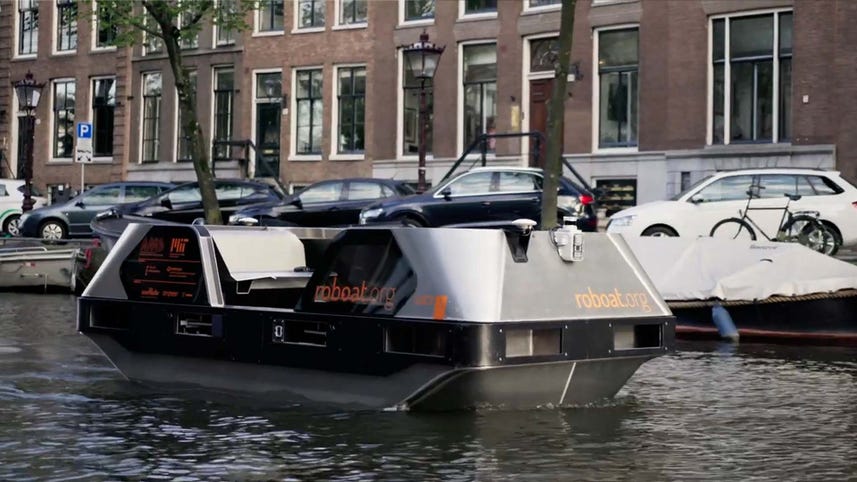
Speaker 1: These autonomous robot prototypes are fully electric water, taxis, trash collectors, cargo transporters. And when they work together, they can form like Voltron to make floating infrastructure like a bridge or a dock. Let's check it out. The robot is attempting to demonstrate a different kind of infrastructure. One that can serve many functions with relatively minor adaptations. You
Speaker 2: Can use robots [00:00:30] in order to move people around, to move things around, uh, to create a temporary infrastructure for the city to scan the city, to collect information about the city and also for, for many, many municipal services, such as waste collection.
Speaker 1: That's professor Carlo roti from MIT's sensible city lab
Speaker 2: At sensible city lab. We work with cities all around the world with governments, with, uh, private companies. And we're passionate about how new technologies can change the way we can understand design [00:01:00] and ultimately of in cities.
Speaker 1: The city of Amsterdam is funding robots, R and D. And as a result, two robot prototypes are already being tested on Amsterdam's waters. These full size robots can carry up to five. Passengers are fully electric with batteries lasting for up to 10 hours. The robot
Speaker 2: Is going to be controlled with a touch interface. Don't only see a prototype, but you can imagine both with your phone or with any touch interface. You just insert your destination in the boat. We take you there. [00:01:30] We know human input needed.
Speaker 1: The robot can navigate around obstacles, autonomously, or attach itself to a dock or another robot. But what really sets the robot apart is its modular design, which allows it to serve many different functions.
Speaker 2: Aro is made of two components because the platform, the platform has the propellers, the platform has all the computers, all the sensors. And then you got was on the top of it.
Speaker 1: One of robots, configurations being tested right now is for garbage collection.
Speaker 2: [00:02:00] One of the first thing we actually prototyped in Amsterdam is, is a waste management robot. That's able to collect ways from the city and bring it to landfill or to recycling facilities. Another way to think about robot is also like a floating reconfigurable architecture. Think about a floating pixel service, and then you can connect and you can connect and to do like a temporary bridge between two sides of the canal to have a temporary stage for a concert or something else to respond to an emergency. [00:02:30] So think about this almost as arch among water, how you can have a floating city that can be controlled dynamically to follow people's needs.
Speaker 1: One of the core components of the robot is its autonomous navigation. Something that many car manufacturers and tech companies have already spent a lot of time and money developing. There's
Speaker 2: Something very interesting when you're thinking about an autonomous boat versus an autonomous car, we all know that we are not created level five autonomy. And [00:03:00] the reason is that, you know, a car was very fast in a complex environment, but actually on a snap, the complexity is lower. The speed is lower. And so we are able to get very close level five already today. So you can actually see robots is a way to already experiment. We where we, we, we a condition where cars will be in a few years
Speaker 1: While robos can only be found in Amsterdam for right now, professor Rothi told me that there are many other places [00:03:30] this sort of modular dynamic infrastructure could be put to use in the future.
Speaker 2: Many cities around the planet are actually built next to big about is of water. Uh, and so we already got a lot of interest ranging from, uh, Dubai to Venice, to, to many others. Uh, cool idea. So for now we're prototyping and developing in AMAM, but I would expect it to scale up very quickly. In other places,
Speaker 1: Fabio Duarte, a principle research scientist from MITs sense city [00:04:00] lab told us that the rowboat is still in the research and development phase. The tests in Amsterdam show that the technology works, but it's not ready for the market. Quite yet, as to the question of whether rowboats will enter the world as a government subsidized public service like buses or waste collection, or as a privatized for profit service like tax. These Fabio said it will depend on where the robot model is adopted and the relevant circumstances in those areas.
Speaker 2: As a matter of fact, we're actually looking with the city of Amsterdam [00:04:30] and how we can replace an existing planned bridge with a number of robots, basically instead of having a bridge with a big CapEx investment, what we can do is have built shattering between one side to the other side of the canop
Speaker 1: As always thanks so much for watching I'm host Jesse or see you next time with the fam.